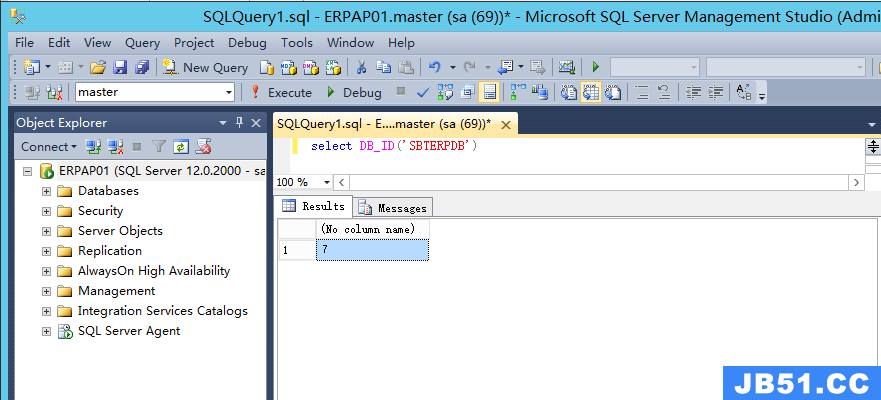感兴趣的小伙伴,下面一起跟随编程之家 jb51.cc的小编两巴掌来看看吧!
运行下面的脚本,建立测试数据库和表值参数。代码如下:
--Create DataBase
create database BulkTestDB;
go
use BulkTestDB;
go
--Create Table
Create table BulkTestTable(
Id int primary key,UserName nvarchar(32),Pwd varchar(16))
go
--Create Table Valued
CREATE TYPE BulkUdt AS TABLE
(Id int,Pwd varchar(16))
下面我们使用最简单的Insert语句来插入100万条数据,代码如下:
代码如下:
Stopwatch sw = new Stopwatch();
sqlConnection sqlConn = new sqlConnection(
ConfigurationManager.ConnectionStrings[ConnStr].ConnectionString);//连接数据库
sqlCommand sqlComm = new sqlCommand();
sqlComm.CommandText = string.Format(insert into BulkTestTable(Id,UserName,Pwd)values(@p0,@p1,@p2));//参数化sql
sqlComm.Parameters.Add(@p0,sqlDbType.Int);
sqlComm.Parameters.Add(@p1,sqlDbType.NVarChar);
sqlComm.Parameters.Add(@p2,sqlDbType.VarChar);
sqlComm.CommandType = CommandType.Text;
sqlComm.Connection = sqlConn;
sqlConn.open();
try
{
//循环插入100万条数据,每次插入10万条,插入10次。
for (int multiply = 0; multiply < 10; multiply++)
{
for (int count = multiply * 100000; count < (multiply + 1) * 100000; count++)
{
sqlComm.Parameters[@p0].Value = count;
sqlComm.Parameters[@p1].Value = string.Format(User-{0},count * multiply);
sqlComm.Parameters[@p2].Value = string.Format(Pwd-{0},count * multiply);
sw.Start();
sqlComm.ExecuteNonQuery();
sw.Stop();
}
//每插入10万条数据后,显示此次插入所用时间
Console.WriteLine(string.Format(Elapsed Time is {0} Milliseconds,sw.ElapsedMilliseconds));
}
}
catch (Exception ex)
{
throw ex;
}
finally
{
sqlConn.Close();
}
Console.ReadLine();
耗时图如下:
【图片暂缺】
由于运行过慢,才插入10万条就耗时72390 milliseconds,所以我就手动强行停止了。
下面看一下使用Bulk插入的情况:
bulk方法主要思想是通过在客户端把数据都缓存在Table中,然后利用sqlBulkcopy一次性把Table中的数据插入到数据库
代码如下:
代码如下:
public static void BulkToDB(DataTable dt)
{
sqlConnection sqlConn = new sqlConnection(
ConfigurationManager.ConnectionStrings[ConnStr].ConnectionString);
sqlBulkcopy bulkcopy = new sqlBulkcopy(sqlConn);
bulkcopy.DestinationTableName = BulkTestTable;
bulkcopy.BatchSize = dt.Rows.Count;
try
{
sqlConn.open();
if (dt != null && dt.Rows.Count != 0)
bulkcopy.WritetoServer(dt);
}
catch (Exception ex)
{
throw ex;
}
finally
{
sqlConn.Close();
if (bulkcopy != null)
bulkcopy.Close();
}
}
public static DataTable GetTableSchema()
{
DataTable dt = new DataTable();
dt.Columns.AddRange(new DataColumn[]{
new DataColumn(Id,typeof(int)),new DataColumn(UserName,typeof(string)), new DataColumn(Pwd,typeof(string))});
return dt;
}
static void Main(string[] args)
{
Stopwatch sw = new Stopwatch();
for (int multiply = 0; multiply < 10; multiply++)
{
DataTable dt = Bulk.GetTableSchema();
for (int count = multiply * 100000; count < (multiply + 1) * 100000; count++)
{
DaTarow r = dt.NewRow();
r[0] = count;
r[1] = string.Format(User-{0},count * multiply);
r[2] = string.Format(Pwd-{0},count * multiply);
dt.Rows.Add(r);
}
sw.Start();
Bulk.BulkToDB(dt);
sw.Stop();
Console.WriteLine(string.Format(Elapsed Time is {0} Milliseconds,sw.ElapsedMilliseconds));
}
Console.ReadLine();
}
耗时图如下:
【图片暂缺】
可见,使用Bulk后,效率和性能明显上升。使用Insert插入10万数据耗时72390,而现在使用Bulk插入100万数据才耗时17583。
最后再看看使用表值参数的效率,会另你大为惊讶的。
表值参数是sql Server 2008新特性,简称TVPs。对于表值参数不熟悉的朋友,可以参考最新的book online,我也会另外写一篇关于表值参数的博客,不过此次不对表值参数的概念做过多的介绍。言归正传,看代码:
代码如下:
public static void TableValuedToDB(DataTable dt)
{
sqlConnection sqlConn = new sqlConnection(
ConfigurationManager.ConnectionStrings[ConnStr].ConnectionString);
const string TsqlStatement =
insert into BulkTestTable (Id,Pwd) +
SELECT nc.Id,nc.UserName,nc.Pwd +
FROM @NewBulkTestTvp AS nc;
sqlCommand cmd = new sqlCommand(TsqlStatement,sqlConn);
sqlParameter catParam = cmd.Parameters.AddWithValue(@NewBulkTestTvp,dt);
catParam.sqlDbType = sqlDbType.Structured;
//表值参数的名字叫BulkUdt,在上面的建立测试环境的sql中有。
catParam.TypeName = dbo.BulkUdt;
try
{
sqlConn.open();
if (dt != null && dt.Rows.Count != 0)
{
cmd.ExecuteNonQuery();
}
}
catch (Exception ex)
{
throw ex;
}
finally
{
sqlConn.Close();
}
}
public static DataTable GetTableSchema()
{
DataTable dt = new DataTable();
dt.Columns.AddRange(new DataColumn[]{
new DataColumn(Id,new DataColumn(Pwd,typeof(string))});
return dt;
}
static void Main(string[] args)
{
Stopwatch sw = new Stopwatch();
for (int multiply = 0; multiply < 10; multiply++)
{
DataTable dt = TableValued.GetTableSchema();
for (int count = multiply * 100000; count < (multiply + 1) * 100000; count++)
{
DaTarow r = dt.NewRow();
r[0] = count;
r[1] = string.Format(User-{0},count * multiply);
dt.Rows.Add(r);
}
sw.Start();
TableValued.TableValuedToDB(dt);
sw.Stop();
Console.WriteLine(string.Format(Elapsed Time is {0} Milliseconds,sw.ElapsedMilliseconds));
}
Console.ReadLine();
}
耗时图如下:
【图片暂缺】
比Bulk还快5秒。
此文原创自CSDN TJVictor

